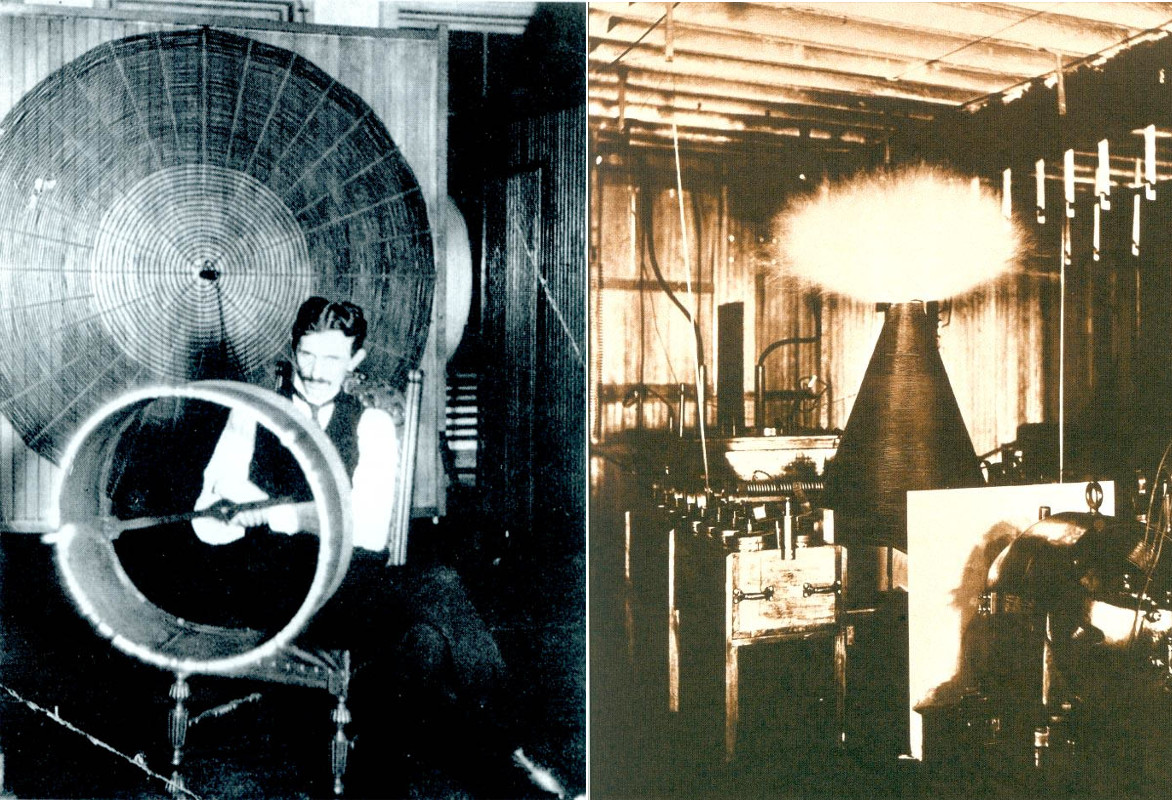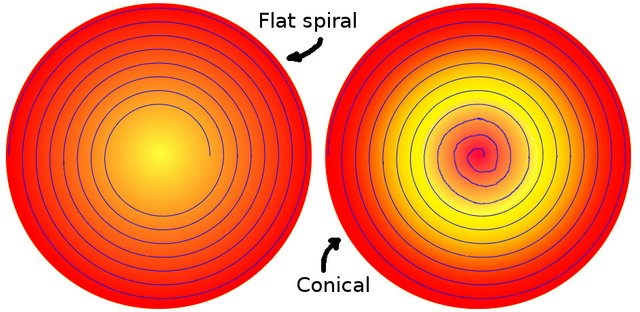Tesla coil geometry
Tesla first used cylindrical coils, but later made flat spirals and a conical coil. He mentions a reason to do this but could he have another reason? One that he did not mention?

When you want to create a high voltage in a coil, it makes sense to keep the wire ends between which this high voltage develops as far apart as possible. Thus we arrive at the single-layer air-core coil that we immediately envision when thinking of Tesla coils.
The first couple of hundred kilovolts can be achieved rather easily, but then it gets more and more power consuming. So Tesla must have looked for ways to increase the efficiency of these coils.
Coupling
Tesla mentions the problem of coupling the primary and secondary coils. You want a tight coupling to quickly transfer the energy of the primary to the secondary, but you want a loose coupling so to have the secondary freely resonating.
If you decrease the circumference of the secondary windings, you decrease the enclosed area, and thus you reduce the coupling. This was his first idea to solve this issue. If you make a flat spiral the outer windings have a tight coupling while the inner windings have a loose coupling, giving you the best of both worlds.
This is the only reason he gives us, I think because reasoning along this line will lead to his final solution of dividing the secondary coil in a tightly coupled secondary and a free ‘extra’ coil.
Yet, understanding his view on electricity there are two more factors to consider.
Compression
When you view electricity as caused by a gaseous medium, increasing the voltage means increasing the pressure. You do this -obviously- by compressing this medium. Now, if you look at a flat spiral and imagine a gaseous content to make one turn. The outer turns are larger and so contain more ‘gas’, which gets compressed into the inner smaller windings. Thus a flat spiral is more efficient in compressing electricity than a cylindrical coil. Similar ideas are later expressed in his bladeless turbine.

Charge distribution and resonance
A flat spiral, however, has one major problem. When viewed as a charged conductor it is easy to see that the charges will have a strong preference to remain on the outside, larger windings. This strong preference works against our wish to create resonance in the coil. So we must do something to break this preference and create a second preferred location for charges to accumulate in the centre of the flat spiral. This can be achieved by pulling the centre windings up, creating a conical coil where the top is at least as far from bottom winding as the diameter of this bottom winding.
Now when you apply a DC charge to the coil, charges will collect on the bottom winding but also on the top winding. And with this charge distribution it is much easier to create resonance.
This is what Tesla called his first major breakthrough in the development of his magnifying transmitter, because this was the first step towards efficiently creating the multi million volts that are needed in this device.
I have followed tesla's work and this article gave me new and valuable insight. Thanks!
Apparently smooth's bot is one way and doesn't autocorrect votes if they change. It also punishes whales that want to cast small votes as equals to others.
There is a huge vulnerability exposed by this. I could get smooth to flag all top content.
Think it in another way: if it auto-correct votes quickly, then with the 5-vote per post limit, it will get stuck quickly.
//Edit: if you want to cast small votes, that's OK, but please vote with less than 4,000,000,000,000 rshares. That's our definition of "small".
Correct. Bot will ignore votes less than 4T rshares. Stale votes are dealt with my someone telling bme about it and I fix manually.
Very interesting article, I have never thought of the electromagnetic concept in this way. Wonder what the results would be if we created two competing conical fields that competed with one another? Similar to how gravity and dark matter compete. Wonder what we might capture in between.. Hmm. Thanks for the article, really got me thinking another way.
gravity and dark matter don't... If you go with Tesla (and many others) ideas of the aether (the gaseous medium written above) then you pretty much throw out gravity.
and dark matter only exists in the minds of astronomers who are trying to figure out how gravity holds a galaxy together. Electrical universe theories throw out these concepts.
So, your idea may be correct, but the comparison is based on imaginary things.
See that's why I dislike words so much "gravity", " dark matter", "magnetism", " electricity", "ether", " frequency". Seems we are all talking about the same thing. Energy and how and why it acts and talks the way it does. I do like the Tesla theory though about the ether, everything is energy.
Very interesting and I learned something new about charge distribution and resonance. Tesla was definitely a man before his time